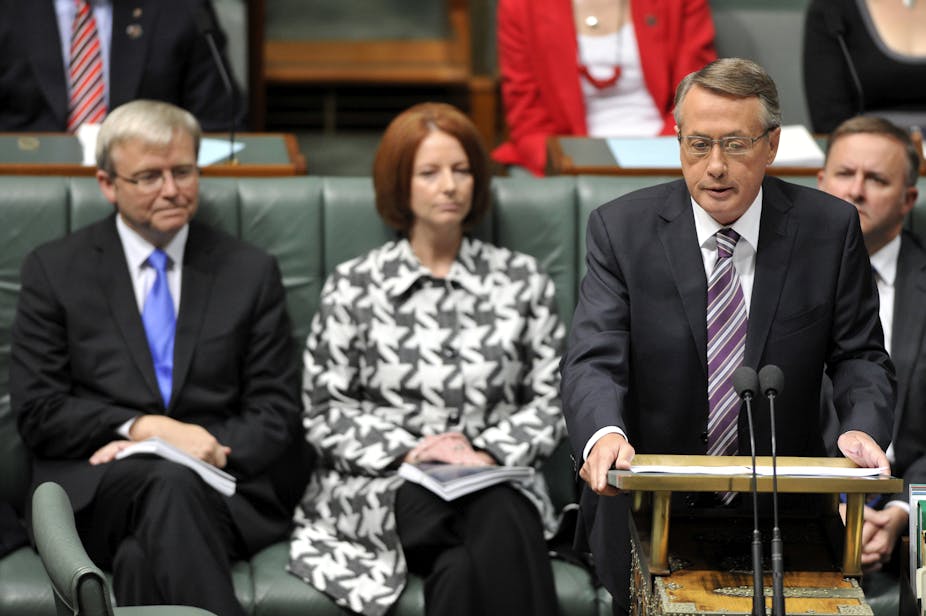Regardless of the result of the next election, the ALP will hold an inquiry into what went wrong. How on earth, they will ask, could a government presiding over low unemployment, low inflation, low levels of public debt and a triple A credit rating be seen as poor economic managers at a time when the rest of the major economies are struggling?
And the answer they will find is a simple one. The government simply didn’t collect enough tax.
Last night’s budget papers make clear that if the proportion of national income collected as tax (the so-called tax/GDP ratio) had remained at the 23.7% the Rudd Government inherited from the Howard Government, then last night’s budget would have been comfortably in surplus even after the expensive Gonski and NDIS announcements.
Similarly, if the government had simply maintained the Howard-era level of tax it wouldn’t have had to cut payments to single mums last year, it wouldn’t have had to scrap the buyout of coal-fired power stations and it wouldn’t have had to cut funding to universities.
Much was made last night by the political commentators of Wayne Swan’s attempts to “booby trap” the budget for an incoming Abbott government. But it was Rudd, Gillard and Swan who walked into John Howard’s booby trap. In fact, so effective was Howard’s trap that many in the ALP don’t even see that they are in it.
Last night the treasurer bragged that “if we were taxing Australian families and Australian businesses like our predecessors did, we’d have an extra $24 billion in taxes in 2013-14 and be comfortably in surplus every year of the forward (estimates)”.
That’s right, that was the Labor Treasurer bragging that he was much better at lifting the “burden” of tax on Australian families and businesses than his neo-liberal counterparts.
The fundamental problem for Labor, however, is not that some of them want to be low taxing neo-liberals; it’s that most of them want to be big spending reformists. Gonski, NDIS, hospital reform, public transport and homemade submarines all cost serious amounts of money. And while a country as rich as Australia can easily afford them, it can only afford them if it’s willing to collect the requisite amount of tax.
So, how did Labor wind up with a strong economy and a weak budget? The same way it wound up with the Pacific solution: John Howard set them up to fail.
In the lead-up to the 2007 election the economy was booming and revenue was flooding in. Howard and Costello had used that revenue to fund substantial income tax cuts and for the 2007 election campaign they promised even more. The Labor party promptly promised almost identical tax cuts which it implemented in the years following Kevin Rudd’s election win.
Those tax cuts have had a big impact on the current budget. Along with those Howard and Costello made in their last three years in office, these cuts are now costing the budget $40 billion a year.
Costello was able to keep the budget in the black because of the cyclical increase in revenue from the boom. But this increased revenue was always going to be temporary. With that temporary windfall gain they funded a permanent cut to income taxes. This was always going to be unsustainable; when the economy returned to more normal economic conditions the structural budget problems were revealed.
These income tax cuts have made the budget unsustainable by creating a structural hole in the ability of the government to collect revenue. Last year’s budget lost a quarter of the income tax it could have collected because of the tax cuts. Such a big change to the ability of the budget to generate income was always going to have an impact when the boom slowed down.
The income tax cuts were also heavily skewed to high income earners. Over the past seven years they have cost the budget $169 billion, of which 43% or $71 billion went to the top 10% of income earners. This was more than the total benefit of tax cuts to the bottom 80%, who together received only $63 billion.
The income tax cuts mainly increased the threshold at which the top marginal tax rate applies. In fact, this threshold was increased so much that as of last year only 2.7% of taxpayers faced the top tax rate.
Of course, it isn’t just the income tax cuts that have prevented the Gillard government from achieving its big reforms and cherished budget surpluses. There was the mining tax - designed to appease miners rather than collect revenue - and the carbon price that came with such generous compensation it runs at a loss.
Australia is one of the richest countries in the world, living at the richest point in world history. The idea that we can’t afford to invest in excellent health or education is ridiculous; the claim that we can’t afford to provide more help to poor countries is appalling.
Australian governments can afford to do anything they want, but they can’t afford to do everything they want. Especially when they want to brag about how little tax they collect.
One day soon the ALP is going to have to decide if it wants to chase the Liberals down the low tax/fend for yourself American path or talk honestly with the public about the fact that tax is the price we pay to live in a civilised society. Hopefully the party chooses the latter. And hopefully it hurries up and actually makes a choice, because the current farce is as destructive to public debate as it is to policy development.
Richard Denniss is the Executive Director of The Australia Institute, a Canberra based think tank. Matt Grudnoff is The Australia Institute’s Senior Economist.

